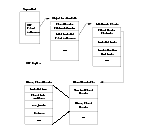VxFS Version 4 Disk Layout
The Version 4 disk layout allows the file system to scale easily to accommodate large files and large file systems.
The original disk layouts divided up the file system space into allocation units. The first AU started part way into the file system which caused potential alignment problems depending on where the first AU started. Each allocation unit also had its own summary, bitmaps, and data blocks. Because this AU structural information was stored at the start of each AU, this also limited the maximum size of an extent that could be allocated. By replacing the allocation unit model of previous versions, the need for alignment of allocation units and the restriction on extent sizes was removed.
The VxFS Version 4 disk layout divides the entire file system space into fixed size allocation units. The first allocation unit starts at block zero and all allocation units are a fixed length of 32K blocks. (An exception may be the last AU, which occupies whatever space remains at the end of the file system). Because the first AU starts at block zero instead of part way through the file system as in previous versions, there is no longer a need for explicit AU alignment or padding to be added when creating a file system.
The Version 4 file system also moves away from the model of storing AU structural data at the start of an AU and puts all structural information in files. So expanding the file system structures simply requires extending the appropriate structural files. This removes the extent size restriction imposed by the previous layouts.
All Version 4 structural files reside in the structural fileset. The structural files in the Version 4 disk layout are:
object location table file
|
Contains the object location table (OLT). The OLT, which is referenced from the super-block, is used to locate the other structural files.
|
label file
|
Encapsulates the super-block and super-block replicas. Although the location of the primary super-block is known, the label file can be used to locate super-block copies if there is structural damage to the file system.
|
device file
|
Records device information such as volume length and volume label, and contains pointers to other structural files.
|
fileset header file
|
Holds information on a per-fileset basis. This may include the inode of the fileset's inode list file, the maximum number of inodes allowed, an indication of whether the file system supports large files, and the inode number of the quotas file if the fileset supports quotas. When a file system is created, there are two filesets---the structural fileset defines the file system structure, the primary fileset contains user data.
|
inode list file
|
Both the primary fileset and the structural fileset have their own set of inodes stored in an inode list file. Only the inodes in the primary fileset are visible to users. When the number of inodes is increased, the kernel increases the size of the inode list file.
|
inode allocation unit file
|
Holds the free inode map, extended operations map, and a summary of inode resources.
|
log file
|
Maps the block used by the file system intent log.
|
extent allocation unit state file
|
Indicates the allocation state of each AU by defining whether each AU is free, allocated as a whole (no bitmaps allocated), or expanded, in which case the bitmaps associated with each AU determine which extents are allocated.
|
extent allocation unit summary file
|
Contains the AU summary for each allocation unit, which contains the number of free extents of each size. The summary for an extent is created only when an allocation unit is expanded for use.
|
free extent map file
|
Contains the free extent maps for each of the allocation units.
|
quotas files
|
There is a quotas file which is used to track the resources allocated to each user and a quotas.grp file to track the resources allocated to each group.
|
The following figure shows how the kernel and utilities build information about the structure of the file system. The super-block location is in a known location from which the OLT can be located. From the OLT, the initial extents of the structural inode list can be located along with the inode number of the fileset header file. The initial inode list extents contain the inode for the fileset header file from which the extents associated with the fileset header file are obtained.
As an example, when mounting the file system, the kernel needs to access the primary fileset in order to access its inode list, inode allocation unit, quotas file and so on. The required information is obtained by accessing the fileset header file from which the kernel can locate the appropriate entry in the file and access the required information.
The Version 4 disk layout supports Access Control Lists and Block-Level Incremental (BLI) Backup. BLI Backup is a backup method that stores and retrieves only the data blocks changed since the previous backup, not entire files. This saves times, storage space, and computing resources required to backup large databases. This file system technology is implemented in other VERITAS products. For information on how to use this feature, contact your sales channel.
VxFS Version 4 Disk Layout

Click the thumbnail above to view full-sized image.
|
